
~ MaThS is FuN ~
HoPe u WiLL LuV MaThEmaTiCs fOrEvEr.....
Dapatkan tips-tips yang mudah untuk belajar matematik.....anda pasti menyukai subjek matematik nanti...blog ini khas buat pelajar-pelajar kesayanganku....di harap dapat memberi manfaat kepada kalian semua...AMeeN....
Friday 18 May 2012
Wednesday 9 May 2012
Our Number System is based on ten.
Using only ten symbols (called Digits) we can write any number.
Using only ten symbols (called Digits) we can write any number.
The Ten Digits
The Digits we use today are called "Hindu-Arabic Numerals" and look like these:0 1 2 3 4 5 6 7 8 9
You can use these on their own to count up to 9.
Ten Or More ...
When we have more than 9 items, we start another column - the "tens" column - and we write down how many "tens" we have, followed by how many ones (called "units"):| Tens | Units |
| 1 | 2 |
The Number "12"
So we know that we have 1 Ten and 2 Ones, which makes 12.
This could also be written as 1 × 10 + 2 × 1.
Example: "35" means 3 Tens and 5 Units, which is also 3 × 10 + 5 × 1
A Hundred Or More ...
When we have more than 99 items, we start another column - the "hundreds" column. Now we need to show how many hundreds, tens and units:| Hundreds | Tens | Units |
| 1 | 4 | 3 |
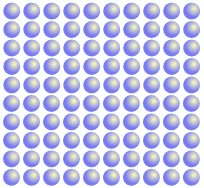 |
The Number 143
So we know that we have 1 Hundred, 4 Tens and 3 Ones
This could also be written as 1 × 100 + 4 × 10 + 3 × 1.
Example: "369" means 3 Hundreds, 6 Tens and 9 Units, which is also 3×100 + 6×10 + 9×1
And So On ...
So, each time we need to show a bigger number we just add one column to the left and we know it is always 10 times bigger than than the column on its right.each new column on the left is ten times bigger
So, where we PLACE a digit is important!Zero
What if we have 1 Ten, but no Units? We show that we have no units by using a zero there:Tens | Units |
| 1 | 0 |
The Number "10"
We have to put a zero, or "10" would look like "1".
We use the same thing to show zero tens, hundreds, etc Example: "203" means 2 Hundreds, Zero Tens and 3 Units.
Names for Each Column
These are the names of each column:| Millions | Hundred-Thousands | Ten-Thousands | Thousands | Hundreds | Tens | Units |
Example:
In a place-value table write down the number eleven thousand, three hundred and twenty seven:| Ten-Thousands | Thousands | Hundreds | Tens | Units |
| 1 | 1 | 3 | 2 | 7 |
The Number 11,327

Thursday 19 April 2012
A fraction is a part of a whole
Slice a pizza, and you will have fractions:
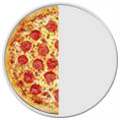 | 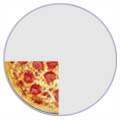 | 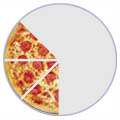 |
| 1/2 | 1/4 | 3/8 |
| (One-Half) | (One-Quarter) | (Three-Eighths) |
| The top number tells how many slices you have The bottom number tells how many slices the pizza was cut into. | ||
Numerator / Denominator
We call the top number the Numerator, it is the number of parts you have.
We call the bottom number the Denominator, it is the number of parts the whole is divided into.
We call the bottom number the Denominator, it is the number of parts the whole is divided into.
| Numerator |
| Denominator |
You just have to remember those names! (If you forget just think "Down"-ominator)
Equivalent Fractions
Some fractions may look different, but are really the same, for example:
| 4/8 | = | 2/4 | = | 1/2 |
| (Four-Eighths) | Two-Quarters) | (One-Half) | ||
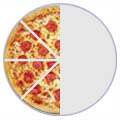 | = | 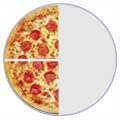 | = |  |
It is usually best to show an answer using the simplest fraction ( 1/2 in this case ). That is called Simplifying, or Reducing the Fraction
Adding Fractions
You can add fractions easily if the bottom number (the denominator) is the same:
| 1/4 | + | 1/4 | = | 2/4 | = | 1/2 |
| (One-Quarter) | (One-Quarter) | (Two-Quarters) | (One-Half) | |||
 | + |  | = |  | = |  |
Another example:
| 5/8 | + | 1/8 | = | 6/8 | = | 3/4 |
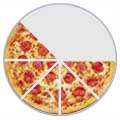 | + | 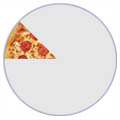 | = | 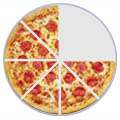 | = | 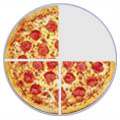 |
Adding Fractions with Different Denominators
But what if the denominators (the bottom numbers) are not the same? As in this example:
| 3/8 | + | 1/4 | = | ? | ||
 | + |  | = | 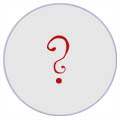 |  |
You must somehow make the denominators the same.
In this case it is easy, because we know that 1/4 is the same as 2/8 :
| 3/8 | + | 2/8 | = | 5/8 | ||
 | + | 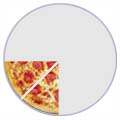 | = |  |

When you say "Percent" you are really saying "per 100"
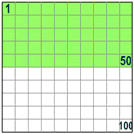 | So 50% means 50 per 100 (50% of this box is green) | And 25% means 25 per 100 (25% of this box is green) | 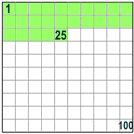 | |
Examples:
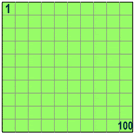 | 100% means all. Example: 100% of 80 is 100/100 × 80 = 80 | |
 | 50% means half. Example: 50% of 80 is 50/100 × 80 = 40 | |
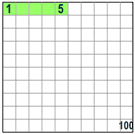 | 5% means 5/100ths. Example: 5% of 80 is 5/100 × 80 = 4 |
Using PercentBecause "Percent" means "per 100" you should think "this should always be divided by 100" So 75% really means 75/100 And 100% is 100/100, or exactly 1 (100% of any number is just the number, unchanged) And 200% is 200/100, or exactly 2 (200% of any number is twice the number) Use the slider on the left and try some different numbers (example, what is 40% of 80?) |
A Percent can also be expressed as a Decimal or a Fraction
 |
|
Some Worked Examples
Example: Calculate 25% of 80
25% = 25/100 (25/100) × 80 = 20
So 25% of 80 is 20
Example: 15% of 200 apples were bad. How many apples were bad?
15% = 15/100 (15/100) × 200 = 15 × 2 = 30 apples
30 apples were badExample: if only 10 of the 200 apples were bad, what percent is that?
As a fraction, 10/200 = 0.05As a percentage it is: (10/200) x 100 = 5%
5% of those apples were bad
Example: A Skateboard is reduced 25% in price in a sale. The old price was $120. Find the new price
First, find 25% of $120:25% = 25/100
(25/100) × $120 = $30
25% of $120 is $30So the reduction is $30
Take the reduction from the original price
$120 - $30 = $90
The Price of the Skateboard in the sale is $90

Wednesday 18 April 2012
(pi =  = 3.141592...)
= 3.141592...)

rectangular prism = a b c
irregular prism = b h
cylinder = b h = pi r 2 h
pyramid = (1/3) b h
cone = (1/3) b h = 1/3 pi r 2 h
sphere = (4/3) pi r 3
ellipsoid = (4/3) pi r1 r2 r3
 = 3.141592...)
= 3.141592...) Volume Formulas
Note: "ab" means "a" multiplied by "b". "a2" means "a squared", which is the same as "a" times "a". "b3" means "b cubed", which is the same as "b" times "b" times "b".
cube = a 3
rectangular prism = a b c

irregular prism = b h

cylinder = b h = pi r 2 h

pyramid = (1/3) b h

cone = (1/3) b h = 1/3 pi r 2 h

sphere = (4/3) pi r 3

ellipsoid = (4/3) pi r1 r2 r3


Monday 9 April 2012
Division is splitting into equal parts or groups.
It is the result of "fair sharing".
Example: there are 12 chocolates, and 3 friends want to share them, how do they divide the chocolates?
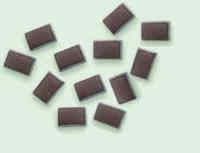 | 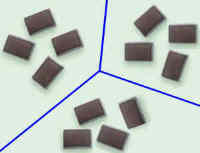 | |
| 12 Chocolates | 12 Chocolates Divided by 3 |
|---|
Answer: 12 divided by 3 is 4: they get 4 each.
Symbols
| ÷ / | We use the ÷ symbol, or sometimes the / symbol to mean divide: 12 ÷ 3 = 4 I will use both symbols here so you get used to it. 12 / 3 = 4 |
Opposite of Multiplying
Division is the opposite of multiplying. If you know a multiplication fact you can find a division fact: Example: 3 × 5 = 15, so 15 / 5 = 3.
Also 15 / 3 = 5.
Why? Well it is easy to understand if you think of the numbers in rows and columns like in this illustration: Also 15 / 3 = 5.
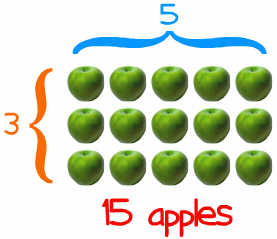 |
| ||||||||||||||||
- 3 × 5 = 15
- 5 × 3 = 15
- 15 / 3 = 5
- 15 / 5 = 3
Example: What is 56 ÷ 7 ?
Searching around the multiplication table you find that 56 is 7 × 8, so 56 divided by 7 must be 8. Answer: 56 ÷ 7 = 8.Names
There are special names for each number in a division:dividend ÷ divisor = quotient
Example: in 12 ÷ 3 = 4:
- 12 is the dividend
- 3 is the divisor
- 4 is the quotient
But Sometimes It Does Not Work Perfectly!
Sometimes you cannot divide things up evenly ... there may be something left over.Example: There are 7 cookies, and 2 people want to share them equally.
But 7 cookies cannot be divided exactly into 2 groups,
each person gets 3 cookies,
but there will be 1 left over:
each person gets 3 cookies,
but there will be 1 left over:
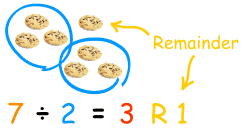

Subscribe to:
Posts (Atom)



Only works if first digits are the same, and both last digits sum up 10
33 x 37 -> 3+7=10 (first digits = 3)
56 x 54 -> 6+4=10 (first digits = 5)
21 x 29 -> 1+9=10 (first digits = 2)
112 x 118 ->2+8=10 (first digits = 11)